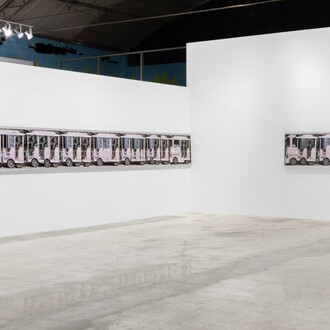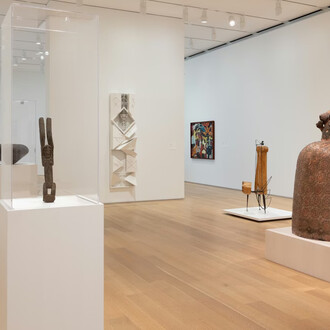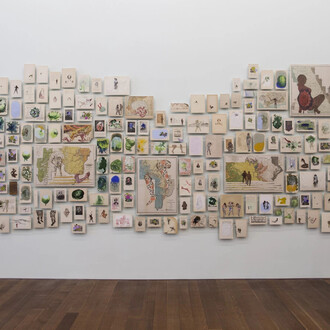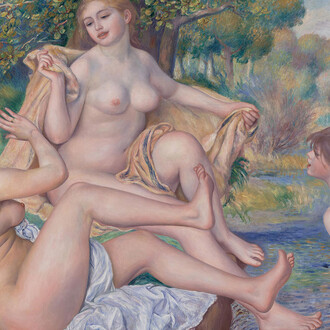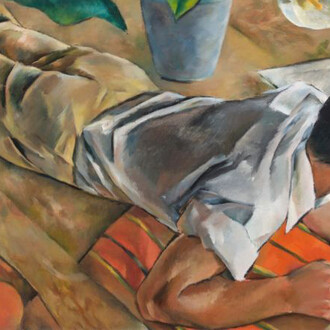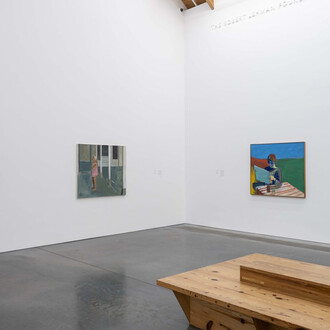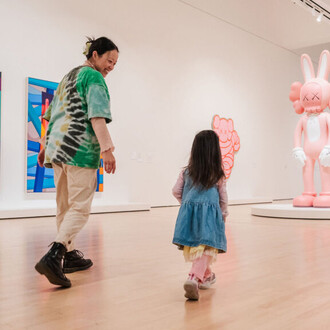From 24 May to 23 August 2014 Carpenters Workshop Gallery will host a unique group show in its Parisian gallery in Le Marais. Entitled Organic, this new exhibition presents artworks of 12 designers, all characterized by their inventiveness, as well as their vast range of colours used and materials employed here.
Inspired or created from vegetable, animal or organic shapes and textures, these works intend to highlight nature’s aesthetic dimension, as can be seen from the Campana Brothers’ Pirarucu’s skin (giant Amazonian fish) buffet.
The artists have imagined functional sculptures whose shapes refer to the complexity of the organic reality, thus inventing a new vocabulary through their reinterpretation of nature’s elements.
List of exhibited artists :
Atelier Van Lieshout
Multidisciplinary art collective Atelier Van Lieshout (AVL) experiments across a diverse range of practices including sculpture, design, painting and architecture to create thematic bodies of work. Evocative themes such as political ideology, organic philosophy and existentialism permeate the work. Combining Surrealist and Minimalist forms, AVL creates striking works with controversial or sinister nuances, while at the same time conveying a lighter, humorous side. AVL’s work has been exhibited at the World Expo 2010 Shanghai, the V&A London and Harvard University USA. They are also part of many major museum collections including: the Museum of Modern Art (New York); FNAC (Paris); Stedelijk Museum (Amsterdam); Prada Foundation (Milan); Museum für Gegenwartskunst (Zürich).
Andrea Branzi
Andrea Branzi, architect and designer, born in Florence in 1938, where he graduated in 1967, lives and works in Milano. From 1964 to 1974 he was a partner of Archizoom Associati, first vanguard group internationally known, whose projects are preserved at Centro Studi e Archivio della Comunicazione in Parma and at Centre Georges Pompidou in Paris. Since 1967 he works in the fields of industrial and research design, architecture, urban planning, education and cultural promotion. He is Professor at the Third Faculty of Architecture and Industrial Design of Politecnico di Milano. As a freelance journalist, he collaborates with the main Italian and foreign magazines. Many are his works as a theorist and essayist. He has been consulting editor of Idea Books, Interni, Interni Annual and of Passigli Progetti. Andrea Branzi is the only Italian author in this filed who has published his books for the Massachussets Institute of Technology. He has held lectures and seminars in Italy, France, Holland, Belgium, England, United States, Japan, Argentine, Brazil, Canada, Israel, Thailand, as a visiting professor in the main Universities.
Humberto & Fernando Campana
Humberto & Fernando Campana have been solidly building their design career through innovation by incorporating the idea of transformation and reinvention. Working in close partnership with Brazilian communities, a strong social mission permeates the Campana Brothers’ ethos. Employing local factories and industries to produce their work provides close connections to the culture and heritage of Brazil. Giving preciousness to banal, day-to-day or common materials carries not only the creativity of the designs, but also distinctly Brazilian characteristics – the colours, the mixtures of materials, the creative chaos, and the triumph of the simple solutions. Based in Sao Paulo, Estudio Campana is constantly investigating new possibilities in furniture making, forming bridges and dialogues where the exchange of information is also a source of inspiration.
Wendell Castle
Wendell Castle’s work is recognized for its sardonic sense of humour and uniquely sculptural use of materials, including his signature use of stack-laminated wood. He has continually reinvented himself for half a century, approaching 80 years old with no signs of slowing down. Often credited as the founding father of the American crafts movement, changing the way we view furniture and expanding the possibilities of design and art, Castle has redesigned sculpture and design by seamlessly fusing the two into one genre. Born in Kansas in 1932, Wendell Castle received a B.F.A. from the University of Kansas in Industrial Design in 1958 and an M.F.A. in Sculpture, graduating in 1961. He moved to Rochester, New York to teach at the School of American Craftsmen and established a permanent studio in the area, which is still operating today. He is now amongst the pantheon of great contemporary designers, whose work can be found in the permanent collections of over 40 museums and cultural institutions, including the Metropolitan Museum of Art in New York, Museum of Modern Art in New York and The White House, Washington.
Ingrid Donat
Ingrid Donat creates sculpted furniture, most often in bronze. Taking a painterly approach to this weighty medium, Donat draws on diverse decorative influences including Art Deco, tribal tattooing, the work of Gustav Klimt and Armand-Albert Rateau, which have all inspired the intricate patterning of her work. Elements of Donat’s practice remain consistent. Her creative process begins with a sheet of wax, which she inscribes, carves and shapes to form the ‘skin’ of her work. This structure is then applied to her designs. She herself engraves the bronzes, paints the upholstery and treats the wood. Her pieces have been cast at the same bronze foundry, the Blanchet-Landowski, for over 20 years, evident by the stamp each piece bears, signifying the quality and artisanal craftsmanship that goes into every work.
Vincent Dubourg
Vincent Dubourg’s sculptural furniture creates contemporary allusions to traditional methods of cabinet making, evoking a nostalgic sense of the familiar while simultaneously distorting these antiquated forms with his fresh approach to materials and technique. He poetically fuses the crafts of glass blowing, wood-bending and metal-casting to deconstruct our perceptions of simple forms and breathe new life into the past. CWG has proudly presented Dubourg in London since its inception, with exhibitions including Design Povera 2007 and ‘Inside’ in 2011.
Lonneke Gordijn & Ralph Nauta
Both graduates from the Design Academy Eindhoven, Ralph Nauta and Lonneke Gordijn founded Studio Drift together with the vision of creating works that react to & question human behavior in 2006. Lonneke Gordijn & Ralph Nauta’s work includes the Flylight, Fragile Future 3 (FF3), Shylight, Dandelight. Their most widely known work FF3 is made with real dandelion seeds that are attached to the light by hand; seed by seed. Since 2006 their work has been exhibited at leading museums and fairs worldwide, including the Victoria & Albert Museum London, Salone del Mobile Milan, World Expo Shanghai, Design/ Miami, Boijmans van Beuningen museum, Design Week Tokyo, Design Act Moscow, Museum of Arts & Design New York, The Israel Museum, PAD and La Biennale di Venezia.
Joris Laarman
The amalgamation of science, nature and philosophy is reflected throughout Joris Laarman’s work. Laarman uses computer technology to inform his emulation of skeletal growth patterns in design. Bones grow thicker or thinner depending on needs of the structure. Laarman transfers this efficiency of design to the form of his chair, made from aluminium, and chaise lounge, made from polyurethane based resin. Laarman’s work has been exhibited at the Museum of Modern Art (New York); The Cooper Hewitt Museum (New York); Le Grand Palais (Paris), Designtide (Tokyo) and The Victoria and Albert Museum (London).
Frederik Molenschot
Frederik Molenschot creates monumental lighting structures from cast bronze, carefully hand shaped into intricate, mesmerizing patterns of light. As the founder of Studio Molen, he has recently joined the team of artists featured at Carpenters Workshop Gallery and is quickly emerging as a household name in the design industry. Inspired by city lights and the night sky, the work embodies his vision of a future world; ‘where cities will keep on getting bigger and bigger and become so big that eventually they’ll hit each other, so the city of the future will actually be a mega-structure of several cities that have merged together.’
Marc Quinn
Marc Quinn’s wide-ranging oeuvre displays a preoccupation with the mutability of the body and the dualisms that define human life: spiritual and physical, surface and depth, cerebral and sexual. Using an uncompromising array of materials, from ice and blood to glass, marble or lead, Quinn develops these paradoxes into experimental, conceptual works that are mostly figurative in form. Quinn’s diverse and poetic work meditates on our attempts to understand or overcome the transience of human life through scientific knowledge and artistic expression. Marc Quinn has exhibited in many important group and solo exhibitions internationally and is a great artistic force of our time.
Rick Owens
"9 years ago when Hun and I moved to Paris, I continued making the custom improvised furniture I'd had made for our bunker complex on Hollywood Boulevard. Rough lumber models of Robert Mallet Stevens and Claude Parent silhouettes. But as we settled in, and Hun started looking around, the city, and time, might have done something to us. Whereas before I had done something in crudely nailed black plywood, Hun found someone to translate that shape into darkly translucent five hundred thousand year old petrified wood. She turned our huge army blanket upholstered bed from L.A into Alabaster for Paris. A raw lumber curial chair became softly matte white marble.
I suggest a few shapes and she diligently coaxes them out of the various talented and temperamental artisans that it takes to make them. Frankly, I suspect them of taking longer so they can receive more of her visits.
The rough black plywood we love is always there, but now there are moments of gleaming opulence……
9 years later everything’s different and everything’s still the same. The furniture has been a deeply personal exercise in building our own little world.
Welcome to it.”
Charles Trevelyan
With a background in material engineering and three-dimensional design, emerging Australian designer Charles Trevelyan creates striking organic forms from an innovative range of materials. Now based in London, Trevelyan works as a furniture and product designer. His works display a balanced combination between graphic character and functional practicality, resulting from his engineering background. The designer believes that such pieces represent more than an artwork because of its functional aspect. Trevelyan has worked on lighting projects for both the retailer Heal’s and London manufacturer 2PM.
Carpenters Workshop Gallery
54 Rue De La Verrerie
Paris 75004 France
Ph. +331 42 788092
paris@carpentersworkshopgallery.com
www.carpentersworkshopgallery.com
Opening hours
Monday - Saturday
From 10am to 7pm or by appointment
Related images
1 & 3. Ingrid Donat, Hommage a Groult, 2011, bronze, 167 x 53 x 40 cm / 65.7 x 20.8 x 15.8 in, limited edition of 8 + 4 AP, Courtesy Carpenters Workshop Gallery
2. Humberto & Fernando Campana, Pirarucu Buffet, 2013, Pirarucu’s leather, straw and wood, 92 x 202 x 50 cm / 36.2 x 79.5 x 19.7 in, limited edition of 8 + 4 AP, Courtesy Carpenters Workshop Gallery
4 & 6. Atelier Van Lieshout, Fossil Chair (Blue), 2009, polyurethane foam on a polyester shell, Icelandic long hair sheepskin, 130 x 103 x 93 cm / 51.1 x 40.5 x 36.6 in, limited edition of 7 + 5 ap, Courtesy Carpenters Workshop Gallery
5. Rick Owens, Onedent, 2013, ox bone, 75 x 47 x 40 cm / 29.5 x 18.5 x 15.7 in, limited edition of 8 + 4 ap, Courtesy Carpenters Workshop Gallery







